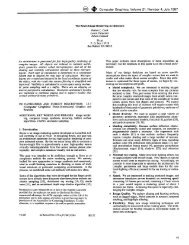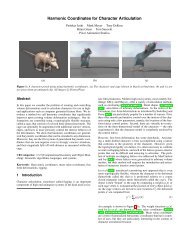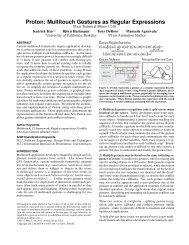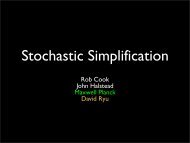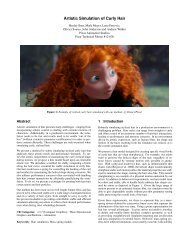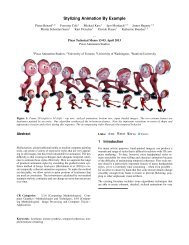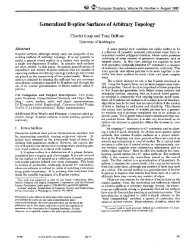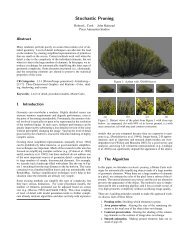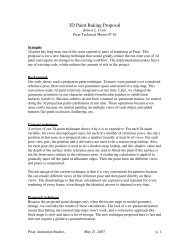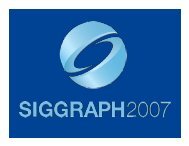Ray Tracing for the Movie 'Cars'.pdf - Pixar Graphics Technologies
Ray Tracing for the Movie 'Cars'.pdf - Pixar Graphics Technologies
Ray Tracing for the Movie 'Cars'.pdf - Pixar Graphics Technologies
You also want an ePaper? Increase the reach of your titles
YUMPU automatically turns print PDFs into web optimized ePapers that Google loves.
ABSTRACT<br />
<strong>Ray</strong> <strong>Tracing</strong> <strong>for</strong> <strong>the</strong> <strong>Movie</strong> ‘Cars’<br />
Per H. Christensen ∗ Julian Fong David M. Laur Dana Batali<br />
This paper describes how we extended <strong>Pixar</strong>’s RenderMan renderer<br />
with ray tracing abilities. In order to ray trace highly complex<br />
scenes we use multiresolution geometry and texture caches, and<br />
use ray differentials to determine <strong>the</strong> appropriate resolution. With<br />
this method we are able to efficiently ray trace scenes with much<br />
more geometry and texture data than <strong>the</strong>re is main memory. <strong>Movie</strong>quality<br />
rendering of scenes of such complexity had only previously<br />
been possible with pure scanline rendering algorithms. Adding ray<br />
tracing to <strong>the</strong> renderer enables many additional effects such as accurate<br />
reflections, detailed shadows, and ambient occlusion.<br />
The ray tracing functionality has been used in many recent<br />
movies, including <strong>Pixar</strong>’s latest movie ‘Cars’. This paper also describes<br />
some of <strong>the</strong> practical ray tracing issues from <strong>the</strong> production<br />
of ‘Cars’.<br />
1 INTRODUCTION<br />
<strong>Pixar</strong>’s RenderMan renderer (PRMan) is a robust production renderer<br />
that is used <strong>for</strong> many CG movies and special effects [1].<br />
PRMan uses <strong>the</strong> REYES scanline rendering algorithm [4]. About<br />
five years ago, at <strong>the</strong> request of our external customers, we started<br />
a project to add on-demand ray tracing to PRMan.<br />
At roughly <strong>the</strong> same time, John Lasseter and his team started<br />
working on ‘Cars’, a movie that would turn out to be an ideal testing<br />
ground and showcase <strong>for</strong> <strong>the</strong> ray tracing functionality. There were<br />
two main rendering challenges in making <strong>the</strong> movie. First, ‘Cars’<br />
has scenes that are much more complex than past <strong>Pixar</strong> movies; <strong>for</strong><br />
example, wide desert landscapes with many sagebrush and thorncovered<br />
cacti, and a racing oval with 75,000 cars as spectators. Second,<br />
ray tracing effects such as correct reflections, shadows, and<br />
ambient occlusion were needed to get <strong>the</strong> desired artistic look. <strong>Ray</strong><br />
tracing <strong>the</strong>se very complex scenes in manageable time was quite a<br />
challenge.<br />
The REYES algorithm is very efficient at handling complex<br />
scenes. For ray tracing, we use ray differentials [6, 14] to select <strong>the</strong><br />
optimal tessellation level of surfaces and <strong>the</strong> proper MIP map level<br />
<strong>for</strong> textures. A multiresolution geometry cache keeps recently tessellated<br />
geometry ready <strong>for</strong> fast access. Similarly, a multiresolution<br />
∗ e-mail: {per,jfong,dml,dana}@pixar.com<br />
<strong>Pixar</strong> Animation Studios<br />
texture cache keeps recently accessed texture tiles ready <strong>for</strong> fast access.<br />
This combination of ray differentials and caching makes ray<br />
tracing of very complex scenes feasible.<br />
This paper first gives a more detailed motivation <strong>for</strong> <strong>the</strong> use of<br />
ray tracing in ‘Cars’, and lists <strong>the</strong> harsh rendering requirements in<br />
<strong>the</strong> movie industry. It <strong>the</strong>n gives an overview of how <strong>the</strong> REYES algorithm<br />
deals with complex scenes and goes on to explain our work<br />
on efficient ray tracing of equally complex scenes. An explanation<br />
of our hybrid rendering approach, combining REYES with ray tracing,<br />
follows. Finally we measure <strong>the</strong> efficiency of our method on a<br />
test scene, and present a few production details from <strong>the</strong> use of ray<br />
tracing <strong>for</strong> ‘Cars’.<br />
Please refer to Christensen et al. [3] <strong>for</strong> an overview of previous<br />
work such as <strong>the</strong> Toro [10] and Kilauea [7] renderers. Recent<br />
related work includes an interactive out-of-core renderer by<br />
Wald et al. [15], <strong>the</strong> Razor project by Stoll et al. [13], and level-ofdetail<br />
representations <strong>for</strong> efficient ray tracing of simplified geometry<br />
[2, 18]. The focus of those projects is more on interactive or<br />
real-time rendering than on movie-quality images.<br />
2 MOTIVATION: WHY RAY TRACING?<br />
There are several reasons why <strong>the</strong> directors chose to use ray tracing<br />
<strong>for</strong> ‘Cars’: realistic reflections, sharp shadows, and ambient occlusion.<br />
Real cars are usually shiny, and <strong>the</strong> reflections are an important<br />
visual cue to <strong>the</strong> shape and material of <strong>the</strong> car. With scanline algorithms<br />
such as REYES, reflections are usually computed using<br />
environment maps. However, this approach breaks down when <strong>the</strong><br />
reflected points are close to <strong>the</strong> reflecting points, or if <strong>the</strong> reflected<br />
points are also reflectors. Figure 1 shows two early pre-production<br />
test images of Luigi, a yellow Fiat 500 “Topolino”. The images<br />
compare environment mapping with ray traced reflections. While<br />
<strong>the</strong> environment map reflection in figure 1(left) shows a good approximation<br />
of <strong>the</strong> distant environment, it does not capture interreflections<br />
such as <strong>the</strong> reflections of <strong>the</strong> eyes in <strong>the</strong> hood seen in<br />
figure 1(right).<br />
Shadows give strong cues about <strong>the</strong> lighting and about <strong>the</strong> placement<br />
of objects relative to each o<strong>the</strong>r. Scanline algorithms traditionally<br />
compute shadows using shadow maps [11], and <strong>the</strong>re are<br />
still many cases where a shadow map is <strong>the</strong> most efficient way of<br />
generating high-quality shadows. However, some of <strong>the</strong> scenes in<br />
‘Cars’ use expansive sets but also have a lot of tiny, detailed geometry.<br />
This can lead to resolution problems in shadow maps. Fur<strong>the</strong>rmore,<br />
many scenes contain thousands of light sources, so keeping
Figure 1: Reflection test: (left) with environment map. (right) with<br />
environment map and ray-traced interreflections.<br />
track of <strong>the</strong> shadow map files can become an asset management<br />
problem. Figure 2 shows a frame from <strong>the</strong> final movie with Lightning<br />
McQueen leading a race. This is an example of a large scene<br />
requiring very fine shadow detail. The scene contains nearly 1000<br />
light sources. Using ray traced shadows eliminates <strong>the</strong> resolution<br />
and asset management problems.<br />
Figure 2: <strong>Ray</strong>-traced sharp shadows.<br />
Ano<strong>the</strong>r use of ray tracing is <strong>for</strong> ambient occlusion. Ambient<br />
occlusion [9, 19] is a measure of how much light reaches a point<br />
from a uni<strong>for</strong>mly lit hemisphere. Ambient occlusion is widely used<br />
in movie production since it gives a good indication of creases on<br />
surfaces and spatial proximity of objects, and is a cheap (but crude)<br />
approximation of global illumination. Figure 3 shows ambient occlusion<br />
on three cars in Radiator Springs. Ambient occlusion is<br />
usually computed by shooting many rays to sample <strong>the</strong> coverage of<br />
<strong>the</strong> hemisphere above each point.<br />
Figure 3: Ambient occlusion.<br />
3 MOVIE RENDERING REQUIREMENTS<br />
The rendering requirements in <strong>the</strong> movie industry are extremely<br />
harsh:<br />
• Scene geometry is far too large to fit in memory in tessellated<br />
<strong>for</strong>m.<br />
• Many surfaces are displacement-mapped.<br />
• There may be thousands of textures (too many to fit all in<br />
memory at full resolution) to control reflection parameters and<br />
displacements.<br />
• There can be thousands of light sources.<br />
• All illumination and surface reflection characteristics are controlled<br />
by fully programmable, complex shaders.<br />
In addition, images are typically rendered at high resolution with<br />
motion blur and depth of field. Fur<strong>the</strong>rmore, no spatial or temporal<br />
aliasing is acceptable: no staircase effects, “crawlies”, popping, etc.<br />
4 REYES RENDERING OF COMPLEX SCENES<br />
The REYES algorithm has many desirable properties such as coherent<br />
shader execution, coherent access to geometry and texture<br />
data, simple differential calculations, efficient displacement, fast<br />
motion blur and depth-of-field, and <strong>the</strong> ability to render very complex<br />
scenes.<br />
The REYES algorithm divides each surface into smaller patches,<br />
and each patch is tessellated into a regular grid of tiny quadrilaterals<br />
(aka. micropolygons). The small patches are easy to place into one<br />
(or a few) image tiles. A patch can be thrown away if it is entirely<br />
behind o<strong>the</strong>r opaque patches.<br />
Shading is done at <strong>the</strong> vertices of <strong>the</strong> grid. Shading an entire<br />
grid at a time is advantageous <strong>for</strong> data coherency and differential<br />
calculations as needed <strong>for</strong> e.g. texture filter sizes. The shading rate<br />
is decoupled from visibility calculations: <strong>the</strong>re is typically only one<br />
shading point (grid vertex) per pixel on average, while <strong>the</strong> pixel<br />
sampling rate typically is 4 × 4 <strong>for</strong> static images and even higher<br />
<strong>for</strong> images with motion blur.<br />
The REYES algorithm is very good at handling complex scenes.<br />
First, it can completely ignore all objects outside <strong>the</strong> viewing frustum.<br />
Second, it renders only one small image tile (typically 16×16<br />
or 32 × 32 pixels) at a time. This means that <strong>the</strong> computation only<br />
needs a small fraction of <strong>the</strong> scene geometry and textures at any<br />
given time. This maximizes geometry coherency and minimizes<br />
<strong>the</strong> number of tessellated surfaces that need to be kept in memory at<br />
<strong>the</strong> same time. Fur<strong>the</strong>rmore, as soon as a surface has been rendered,<br />
its data can be removed from memory since <strong>the</strong>y will no longer be<br />
needed. Surfaces are divided and tessellated according to <strong>the</strong>ir size<br />
on screen, so large distant surfaces automatically get a coarse representation.<br />
Likewise, distant objects only need coarse textures,<br />
so only coarse levels in <strong>the</strong> texture MIP maps will be accessed <strong>for</strong><br />
those objects. For all <strong>the</strong>se reasons, REYES deals gracefully with<br />
very complex geometry and huge amounts of texture.<br />
5 RAY TRACING OF COMPLEX SCENES<br />
<strong>Ray</strong> tracing also has several wonderful properties as a rendering<br />
algorithm: it is conceptually simple, its run-time only grows logarithmically<br />
with scene complexity, and it can easily be parallelized.<br />
But ray tracing has an important limitation: it is only efficient if <strong>the</strong><br />
scene fits in memory. If <strong>the</strong> scene does not fit in memory, virtual<br />
memory thrashing slows <strong>the</strong> rendering down by orders of magnitude.
<strong>Ray</strong> tracing of complex scenes is inherently harder than REYES<br />
rendering of similar scenes. First, objects can’t be rejected just because<br />
<strong>the</strong>y are outside <strong>the</strong> viewing frustum: <strong>the</strong>y may cast shadows<br />
on visible objects or be reflected by <strong>the</strong>m. Second, even if <strong>the</strong> image<br />
is rendered one tile at a time and <strong>the</strong> directly visible geometry is<br />
ray traced very coherently, <strong>the</strong> reflection and shadow rays will access<br />
o<strong>the</strong>r geometry (and textures) in a less coherent manner. Even<br />
worse, <strong>the</strong> rays traced <strong>for</strong> diffuse interreflections and ambient occlusion<br />
are completely incoherent and may access any part of <strong>the</strong><br />
scene at any time. Hence, we can’t delete an object even when <strong>the</strong><br />
image tile it is directly visible in has been rendered — a ray from<br />
some o<strong>the</strong>r part of <strong>the</strong> scene may hit that object at any time during<br />
rendering.<br />
For all <strong>the</strong> reasons listed above, ray tracing of very complex<br />
scenes may seem like a daunting task. However, <strong>the</strong> use of ray differentials<br />
and multiresolution geometry and texture caches makes<br />
it tractable.<br />
5.1 <strong>Ray</strong> differentials<br />
A ray differential describes <strong>the</strong> differences between a ray and its<br />
— real or imaginary — “neighbor” rays. Igehy’s ray differential<br />
method [6] traces single rays, but keeps track of <strong>the</strong> differentials<br />
as <strong>the</strong> rays are propagated and reflected. The differentials give an<br />
indication of <strong>the</strong> beam size that each ray represents, as illustrated<br />
in figure 4. The curvature at surface intersection points determines<br />
how <strong>the</strong> ray differentials and <strong>the</strong>ir associated beams change after<br />
specular reflection and refraction. For example, if a ray hits a highly<br />
curved, convex surface, <strong>the</strong> specularly reflected ray will have a large<br />
differential (representing highly diverging neighbor rays).<br />
neighbor ray<br />
ray<br />
ray beam<br />
neighbor ray<br />
Figure 4: <strong>Ray</strong>s and ray beam.<br />
Suykens and Willems [14] generalized ray differentials to glossy<br />
and diffuse reflections. For distribution ray tracing of diffuse reflection<br />
or ambient occlusion, <strong>the</strong> ray differential corresponds to a<br />
fraction of <strong>the</strong> hemisphere. The more rays are traced from <strong>the</strong> same<br />
point, <strong>the</strong> smaller <strong>the</strong> subtended hemisphere fraction becomes. If<br />
<strong>the</strong> hemisphere fraction is very small, a curvature-dependent differential<br />
(as <strong>for</strong> specular reflection) becomes dominant.<br />
In Christensen et al. [3] we provided a comprehensive analysis<br />
of ray differentials vs. ray coherency. We observed that in all practical<br />
cases, coherent rays have narrow beams and incoherent rays<br />
have wide beams. This is an important and very <strong>for</strong>tunate relationship<br />
that enables ray tracing of very complex scenes. We exploit<br />
that relationship in <strong>the</strong> following sections by designing caches that<br />
utilize it.<br />
5.2 Multiresolution tessellation<br />
REYES chooses tessellation rates <strong>for</strong> a surface patch depending on<br />
viewing distance, surface curvature, and optionally also view angle.<br />
In our implementation, <strong>the</strong> highest tessellation rate used <strong>for</strong><br />
ray tracing of a patch is <strong>the</strong> same as <strong>the</strong> REYES tessellation rate<br />
<strong>for</strong> that patch. Subsets of <strong>the</strong> vertices are used <strong>for</strong> coarser tessellations,<br />
which ensures that <strong>the</strong> bounding boxes are consistent: a<br />
(tight) bounding box of <strong>the</strong> finest tessellation is also a bounding<br />
box <strong>for</strong> <strong>the</strong> coarser tessellations. The coarsest tessellation is simply<br />
<strong>the</strong> four corners of <strong>the</strong> patch. One can think of <strong>the</strong> various levels<br />
of tessellation as a MIP map of tessellated geometry [17]. Figure 5<br />
shows an example of five tessellations of a surface patch; here, <strong>the</strong><br />
finest tessellation rate is 14×11.<br />
Figure 5: Multiresolution tessellation example <strong>for</strong> a surface patch:<br />
14×11 quads, 7×6 quads, 4×3 quads, 2×2 quads, and 1 quad.<br />
In our first implementation [3], <strong>the</strong> tessellation rates used <strong>for</strong><br />
ray tracing were 16×16, 8×8, . . . , 1. However, using <strong>the</strong> REYES<br />
tessellation rates and subsets <strong>the</strong>reof has two advantages: <strong>the</strong>re are<br />
fewer quads to test <strong>for</strong> ray intersection (since we always rounded <strong>the</strong><br />
REYES tessellations rates up <strong>for</strong> ray tracing), and <strong>the</strong>re are fewer<br />
self-intersection problems if we use a hybrid rendering method<br />
(since <strong>the</strong> vertices of <strong>the</strong> two representations always coincide when<br />
using <strong>the</strong> current tessellation approach).<br />
The example in figure 5 is a rectangular surface patch. We have<br />
a similar multiresolution tessellation method <strong>for</strong> triangular patches<br />
which arise from triangle meshes and Loop subdivision surfaces.<br />
5.3 Multiresolution geometry cache<br />
We tessellate surface patches on demand and cache <strong>the</strong> tessellations.<br />
As shown above, we use up to five different levels of tessellation<br />
<strong>for</strong> each surface patch. However, we have chosen not to have<br />
five geometry caches; instead we use three caches and create <strong>the</strong><br />
two intermediate tessellations by picking (roughly) a quarter of <strong>the</strong><br />
vertices from <strong>the</strong> next finer tessellation level.<br />
In our implementation, <strong>the</strong> coarse cache contains tessellations<br />
with 4 vertices (1 quad), <strong>the</strong> medium cache contains tessellations<br />
with at most 25 vertices, and <strong>the</strong> fine cache contains all larger tessellations<br />
(at most 289 vertices). The size of <strong>the</strong> geometry caches<br />
can be specified by <strong>the</strong> user. By default, <strong>the</strong> size is 20 MB per thread<br />
allocated <strong>for</strong> each of <strong>the</strong> three caches. Since <strong>the</strong> size of <strong>the</strong> tessellations<br />
differ so much, <strong>the</strong> maximum capacity (number of slots) of<br />
<strong>the</strong> coarse cache is much higher than <strong>for</strong> <strong>the</strong> medium cache, and <strong>the</strong><br />
medium cache has much higher capacity than <strong>the</strong> fine cache. We<br />
use a least-recently-used (LRU) cache replacement scheme.<br />
For ray intersection tests, we choose <strong>the</strong> tessellation where <strong>the</strong><br />
quads are approximately <strong>the</strong> same size as <strong>the</strong> ray beam crosssection.<br />
We have observed that accesses to <strong>the</strong> fine and medium<br />
caches are usually very coherent. The accesses to <strong>the</strong> coarse cache<br />
are ra<strong>the</strong>r incoherent, but <strong>the</strong> capacity of that cache is large and its<br />
tessellations are fast to recompute.<br />
5.4 Multiresolution texture cache<br />
Textures are stored on disk as tiled MIP maps with 32×32 pixels in<br />
each tile. The size of <strong>the</strong> texture cache is chosen by <strong>the</strong> user; <strong>the</strong><br />
default size is 10 MB per thread.<br />
As with <strong>the</strong> geometry cache, <strong>the</strong> ray beam size is used to select<br />
<strong>the</strong> appropriate texture MIP map level <strong>for</strong> texture lookups. We<br />
choose <strong>the</strong> level where <strong>the</strong> texture pixels are approximately <strong>the</strong><br />
same size as <strong>the</strong> ray beam cross-section. Incoherent texture lookups<br />
have wide ray beams, so coarse MIP map levels will be chosen. The<br />
finer MIP map levels will only be accessed by rays with narrow ray<br />
beams; <strong>for</strong>tunately those rays are coherent so <strong>the</strong> resulting texture<br />
cache lookups will be coherent as well.
6 OTHER RAY-TRACING IMPLEMENTATION ISSUES<br />
This section describes o<strong>the</strong>r efficiency and accuracy aspects of our<br />
implementation of ray tracing in PRMan.<br />
6.1 Spatial acceleration data structure<br />
Good spatial acceleration structures are essential <strong>for</strong> efficient ray<br />
tracing. We use a bounding volume hierarchy, <strong>the</strong> Kay-Kajiya<br />
tree [8]. This data structure is a good compromise between memory<br />
overhead, construction speed, and ray traversal speed. The data<br />
structure is built dynamically during rendering. While we are quite<br />
satisfied with <strong>the</strong> per<strong>for</strong>mance of <strong>the</strong> Kay-Kajiya tree, it is certainly<br />
worth considering o<strong>the</strong>r acceleration data structures in <strong>the</strong> future.<br />
There is one more level of bounding volumes <strong>for</strong> <strong>the</strong> finest tessellations:<br />
bounding boxes <strong>for</strong> groups of (up to) 4×4 quads. These<br />
bounding boxes are stored in <strong>the</strong> fine geometry cache along with<br />
<strong>the</strong> tessellated points.<br />
6.2 Displacement-mapped surfaces<br />
Displacement shaders complicate <strong>the</strong> calculation of ray intersections.<br />
If <strong>the</strong> surface has a displacement shader, <strong>the</strong> shader is evaluated<br />
at <strong>the</strong> tessellation vertices to get <strong>the</strong> displaced tessellation.<br />
The bounding box of <strong>the</strong> displaced vertices is computed, and <strong>the</strong><br />
Kay-Kajiya tree is updated with <strong>the</strong> new bounding box.<br />
Although <strong>the</strong>re exist techniques <strong>for</strong> direct ray tracing of displaced<br />
surfaces [12], we have found that applying displacement<br />
shaders to tessellated grids gives much faster rendering times —<br />
at least if <strong>the</strong> displaced tessellations are cached.<br />
Each object that has displacement must have a pre-specified upper<br />
bound on <strong>the</strong> displacement; such bounds are important <strong>for</strong> <strong>the</strong><br />
efficiency of both REYES rendering and ray tracing. Without a priori<br />
bounds, any surface might end up anywhere in <strong>the</strong> scene after<br />
displacement, and this makes image tiling or building an acceleration<br />
data structure futile.<br />
The value of tight bounding boxes is so high that even if <strong>the</strong> first<br />
access to a displaced surface patch only needs a coarse tessellation,<br />
we compute a fine tessellation, run <strong>the</strong> displacement shader, compute<br />
<strong>the</strong> tight bounding box, update <strong>the</strong> Kay-Kajiya tree, and throw<br />
away those tessellation points that aren’t needed. This is a one-time<br />
cost that is amortized by <strong>the</strong> reduction in <strong>the</strong> number of rays that<br />
later have to be intersection-tested against that surface patch. Tight<br />
bounding boxes allow us to ray trace displaced surfaces ra<strong>the</strong>r efficiently.<br />
6.3 Motion blur<br />
PRMan assumes that all motion is piecewise linear. There is a tessellation<br />
<strong>for</strong> <strong>the</strong> start of each motion segment plus a tessellation <strong>for</strong><br />
<strong>the</strong> end of <strong>the</strong> last segment. These tessellations are computed on demand<br />
and stored in <strong>the</strong> geometry cache. For ray intersection tests,<br />
<strong>the</strong> tessellated vertex positions are interpolated according to <strong>the</strong> ray<br />
time, creating a grid at <strong>the</strong> correct time <strong>for</strong> <strong>the</strong> ray.<br />
The Kay-Kajiya node <strong>for</strong> a moving surface patch contains a<br />
bounding box <strong>for</strong> <strong>the</strong> start of each motion segment plus a bounding<br />
box <strong>for</strong> <strong>the</strong> end of <strong>the</strong> last segment. The bounding boxes are<br />
linearly interpolated to find <strong>the</strong> bounding box that corresponds to<br />
<strong>the</strong> ray time.<br />
6.4 SIMD speedups<br />
We use SIMD instructions (SSE and AltiVec) to speed up <strong>the</strong> computation<br />
of ray intersections. When intersection-testing a Kay-<br />
Kajiya node bounding box, we test multiple slabs (x, y, and z<br />
planes) at once. The bounding boxes <strong>for</strong> groups of 4 × 4 quads<br />
of finely tessellated patches (stored in <strong>the</strong> fine geometry cache) are<br />
intersection-tested four boxes at a time. And tessellated patches are<br />
intersection-tested 4 triangles (2 quads) at a time.<br />
Since each ray is traced independently, our SIMD speedups do<br />
not rely on ray coherency. In contrast, Wald et al. [16] used SIMD<br />
instructions <strong>for</strong> tracing four rays at a time. This works fine if <strong>the</strong><br />
rays are coherent, but fails to deliver a speedup if <strong>the</strong> rays are incoherent.<br />
6.5 Shading at ray hit points<br />
To compute <strong>the</strong> shading results at ray hit points, we could shade<br />
<strong>the</strong> vertices of ray tracing tessellations, store <strong>the</strong> colors in a cache,<br />
and interpolate <strong>the</strong> colors at <strong>the</strong> hit points. This would be a straigh<strong>for</strong>ward<br />
generalization of <strong>the</strong> REYES shading approach. But un<strong>for</strong>tunately<br />
<strong>the</strong> shading colors are usually view-dependent — highlights<br />
move around depending on <strong>the</strong> viewing direction, <strong>for</strong> example.<br />
The shader may also compute different results depending on<br />
<strong>the</strong> ray level <strong>for</strong> non-realistic, artistic effects.<br />
Instead we create 3 shading points <strong>for</strong> each ray hit (similar to<br />
Gritz and Hahn [5]). One shading point is <strong>the</strong> ray hit point, and <strong>the</strong><br />
o<strong>the</strong>r two shading points are created using <strong>the</strong> ray differentials at <strong>the</strong><br />
ray hit point. This way, <strong>the</strong> shader can get meaningful differentials<br />
<strong>for</strong> texture filtering, computation of new ray directions, etc. While<br />
most shading functions are executed on all three shading points,<br />
some are only executed at <strong>the</strong> ray hit point — <strong>for</strong> example, rays are<br />
only traced from <strong>the</strong> ray hit point.<br />
It is worth emphasizing that <strong>for</strong> production scenes, <strong>the</strong> dominant<br />
cost of ray tracing is typically not <strong>the</strong> computation of ray intersections,<br />
but <strong>the</strong> evaluation of displacement, surface, and light source<br />
shaders at <strong>the</strong> ray hit points. (This is also why ambient occlusion<br />
has gained popularity in movie production so quickly as an alternative<br />
to more accurate global illumination solutions: even though it<br />
takes a lot of rays to compute ambient occlusion accurately, <strong>the</strong>re<br />
are no shader evaluations at <strong>the</strong> ray hit points.)<br />
6.6 Avoiding cracks<br />
Visible cracks can occur if <strong>the</strong> two grids sharing an edge have different<br />
tessellation rates. See figure 6 <strong>for</strong> an illustration. This is a<br />
potential problem both <strong>for</strong> REYES rendering and <strong>for</strong> ray tracing,<br />
and has to be dealt with explicitly.<br />
cracks<br />
Figure 6: Mismatched tessellation and potential cracks.<br />
The easiest way to fix <strong>the</strong>se cracks requires that all dicing rates<br />
are powers of 2. Then every o<strong>the</strong>r vertex on <strong>the</strong> fine tessellation<br />
side of <strong>the</strong> edge can be moved to lie along <strong>the</strong> straight line between<br />
its two neighbor points. This ensures that <strong>the</strong> vertices on<br />
both sides of <strong>the</strong> edge are consistent so <strong>the</strong>re are no cracks. However,<br />
such power-of-two tessellation (aka. “binary dicing”) introduces<br />
too many shading points compared to more flexible tessellation<br />
rates, and it is <strong>the</strong>re<strong>for</strong>e too expensive in practice when shaders<br />
are a bottleneck.<br />
Instead, PRMan uses an alternative algorithm that glues all edges<br />
toge<strong>the</strong>r [1, sec. 6.5.2], thus avoiding cracks. We call this algorithm<br />
“stitching”. Stitching moves <strong>the</strong> tessellation points so that<br />
<strong>the</strong> grids overlap, and introduces new quads if needed to fill remaining<br />
gaps. For REYES rendering, new quads that are introduced are<br />
never shaded, <strong>the</strong>y only copy colors from <strong>the</strong>ir nearest neighbor.
We use a similar stitching algorithm <strong>for</strong> ray tracing. If any new<br />
quads are generated, <strong>the</strong>y are stored in <strong>the</strong> geometry cache.<br />
The tessellation rate of each surface patch is determined from<br />
<strong>the</strong> size of <strong>the</strong> patch bounding box relative to <strong>the</strong> ray beam size.<br />
Hence, <strong>the</strong> tessellation within a patch is kept consistent <strong>for</strong> each<br />
ray, and <strong>the</strong>re are no cracks internally within a patch. (Such cracks<br />
are sometimes refered to as “tunnelling” [13].)<br />
7 HYBRID RENDERING: REYES AND RAYS<br />
PRMan uses a combination of <strong>the</strong> REYES algorithm and ondemand<br />
ray tracing. REYES is used to render objects that are directly<br />
visible to <strong>the</strong> camera. Shading those objects can cause rays<br />
to be traced. With this hybrid approach <strong>the</strong>re are no camera rays;<br />
all <strong>the</strong> first-level rays originate from REYES shading points.<br />
With <strong>the</strong> methods described above, both <strong>the</strong> REYES and ray tracing<br />
algorithms can handle very complex scenes. So why not use ray<br />
tracing <strong>for</strong> primary rendering? It would unify our algorithm, eliminate<br />
large parts of <strong>the</strong> PRMan code base, and make software maintenance<br />
easier. However, so far <strong>the</strong> advantages of coherency, welldefined<br />
differentials, graceful handling of displacement mapping,<br />
efficient motion blur and depth-of-field, decoupling of shading rate<br />
and pixel sample rate, etc. makes <strong>the</strong> REYES algorithm hard to beat<br />
<strong>for</strong> movie-quality rendering.<br />
8 TEST ON A COMPLEX SCENE<br />
Figure 7 shows a test example, a scene with 15 cars. The cars are<br />
explicitly copied, not instanced. Each car consists of 2155 NURBS<br />
patches, many of which have trim curves. The cars have ray-traced<br />
reflections (maximum reflection depth 4) and sharp shadows, while<br />
<strong>the</strong> ground is shaded with ray-traced ambient occlusion. This gives<br />
a mix of coherent and incoherent rays. The image resolution is<br />
2048×1536 pixels.<br />
Figure 7: Shiny cars on ambient occlusion ground.<br />
The tests were run on an Apple G5 computer with two 2 GHz<br />
PowerPC processors and 2 GB memory.<br />
During rendering <strong>the</strong> car surfaces are divided into 1.3 million<br />
surface patches, corresponding to 383 million vertices and 339 million<br />
quads (678 million triangles) at full tessellation. Storing all full<br />
tessellations would consume 4.6 GB. Instead, with multiresolution<br />
caching, <strong>the</strong> scene uses a total of 414 MB: Geometry cache sizes<br />
are set to <strong>the</strong>ir default value (20 MB per cache per thread), a total<br />
of 120 MB. The Kay-Kajiya tree uses around 59 MB per thread.<br />
The top-level object descriptions use 126 MB plus 50 MB <strong>for</strong> trim<br />
curves.<br />
Rendering this image used 111 million diffuse rays, 37 million<br />
specular rays, and 26 million shadow rays. The rays cause 1.2<br />
billion ray-triangle intersection tests. With multiresolution geometry<br />
caching, <strong>the</strong> render time is 106 minutes. The three geometry<br />
caches have a total of 675 million lookups and cache hit rates of<br />
91.4%–95.2%. In contrast, if <strong>the</strong> ray differentials are ignored (<strong>the</strong><br />
REYES tessellation rates are used <strong>for</strong> all ray intersection tests) and<br />
no caching is done, <strong>the</strong> render time is 15 hours 45 minutes — almost<br />
9 times slower.<br />
More exhaustive tests and results can be found in Christensen<br />
et al. [3]. Although <strong>the</strong> render times reported <strong>the</strong>re are quite obsolete<br />
by now, <strong>the</strong> time ratios and relative speedups are still representative.<br />
9 RAY TRACING FOR ‘CARS’<br />
Figure 8 shows “beauty shots” of two of <strong>the</strong> characters from ‘Cars’.<br />
These images demonstrate ray traced reflections, shadows, and ambient<br />
occlusion.<br />
Figure 8: More cars with ray traced effects: Luigi (left) and Doc<br />
Hudson (right).<br />
For convex surfaces like a car body, distant reflections do not<br />
need to be very accurate. In many shots, <strong>the</strong> maximum distance<br />
that a ray can hit geometry was set to 12 meters. If <strong>the</strong> ray didn’t<br />
hit anything within that distance, it would use a single held environment<br />
map instead.<br />
The reflections in <strong>the</strong> movie were usually limited to a single level<br />
of reflection. There were only a few shots with two levels of reflection,<br />
<strong>the</strong>y are close-ups of chrome parts that needed to reflect<br />
<strong>the</strong>mselves multiple times. Figure 9 shows an example.<br />
Figure 9: Chrome bumper with two levels of ray-traced reflection.
Figure 10 shows all <strong>the</strong> main characters in <strong>the</strong> ‘Cars’ movie. This<br />
is an example of a very complex scene with many shiny cars. The<br />
shiny cars reflect o<strong>the</strong>r cars, as shown in <strong>the</strong> three close-ups. The<br />
image also shows ray-traced shadows and ambient occlusion.<br />
Figure 10: The cast of ‘Cars’ with three close-ups showing ray-traced<br />
reflections.<br />
10 CONCLUSION<br />
PRMan uses <strong>the</strong> REYES algorithm <strong>for</strong> rendering directly visible<br />
objects, and offers on-demand ray tracing <strong>for</strong> reflections, shadows,<br />
ambient occlusion, etc. It uses a multiresolution geometry cache<br />
and a multiresolution texture cache, and uses ray differentials to<br />
select <strong>the</strong> appropriate resolutions. Due to <strong>the</strong> observation that coherent<br />
rays have narrow beams while incoherent rays have wide<br />
beams, <strong>the</strong> method is efficient <strong>for</strong> ray tracing of complex scenes.<br />
The ray tracing functionality has been used <strong>for</strong> several movies, including<br />
<strong>Pixar</strong>’s ‘Cars’.<br />
Acknowledgements<br />
We would like to thank our colleagues in <strong>Pixar</strong>’s RenderMan Products<br />
group <strong>for</strong> providing an inspiring and creative environment and<br />
<strong>for</strong> many helpful discussions. Loren Carpenter implemented most<br />
of <strong>the</strong> SIMD speedups and Brian Smits helped us optimize o<strong>the</strong>r aspects<br />
of <strong>the</strong> ray-tracing efficiency. Tony Apodaca headed <strong>the</strong> Cars<br />
“Nitro” speed team. Erik Smitt clarified some of <strong>the</strong> movie production<br />
details.<br />
All images from ‘Cars’ are copyright c○ Disney Enterprises, Inc.<br />
and <strong>Pixar</strong> Animation Studios.<br />
REFERENCES<br />
[1] Anthony A. Apodaca and Larry Gritz. Advanced RenderMan — Creating<br />
CGI <strong>for</strong> Motion Pictures. Morgan Kaufmann, 2000.<br />
[2] Per H. Christensen. Point clouds and brick maps <strong>for</strong> movie production.<br />
In Markus Gross and Hanspeter Pfister, editors, Point-Based <strong>Graphics</strong>,<br />
chapter 8.4. Morgan Kaufmann, 2006. (In press).<br />
[3] Per H. Christensen, David M. Laur, Julian Fong, Wayne L. Wooten,<br />
and Dana Batali. <strong>Ray</strong> differentials and multiresolution geometry<br />
caching <strong>for</strong> distribution ray tracing in complex scenes. Computer<br />
<strong>Graphics</strong> Forum (Proceedings of Eurographics 2003), 22(3):543–552,<br />
2003.<br />
[4] Robert L. Cook, Loren Carpenter, and Edwin Catmull. The Reyes<br />
image rendering architecture. Computer <strong>Graphics</strong> (Proceedings of<br />
SIGGRAPH ’87), 21(4):95–102, 1987.<br />
[5] Larry Gritz and James K. Hahn. BMRT: A global illumination implementation<br />
of <strong>the</strong> RenderMan standard. Journal of <strong>Graphics</strong> Tools,<br />
1(3):29–47, 1996.<br />
[6] Homan Igehy. <strong>Tracing</strong> ray differentials. Computer <strong>Graphics</strong> (Proceedings<br />
of SIGGRAPH ’99), pages 179–186, 1999.<br />
[7] Toshiaki Kato. The Kilauea massively parallel ray tracer. In Alan<br />
Chalmers, Timothy Davis, and Erik Reinhard, editors, Practical Parallel<br />
Rendering, chapter 8. A K Peters, 2002.<br />
[8] Timothy L. Kay and James Kajiya. <strong>Ray</strong> tracing complex scenes.<br />
Computer <strong>Graphics</strong> (Proceedings of SIGGRAPH ’86), 20(4):269–<br />
278, 1986.<br />
[9] Hayden Landis. Production-ready global illumination. In SIGGRAPH<br />
2002 course note #16, pages 87–102, 2002.<br />
[10] Matt Pharr, Craig Kolb, Reid Gershbein, and Pat Hanrahan. Rendering<br />
complex scenes with memory-coherent ray tracing. Computer<br />
<strong>Graphics</strong> (Proceedings of SIGGRAPH ’97), pages 101–108, 1997.<br />
[11] William T. Reeves, David H. Salesin, and Robert L. Cook. Rendering<br />
antialiased shadows with depth maps. Computer <strong>Graphics</strong> (Proceedings<br />
of SIGGRAPH ’87), 21(4):283–291, 1987.<br />
[12] Brian Smits, Peter Shirley, and Michael M. Stark. Direct ray tracing of<br />
displacement mapped triangles. In Rendering Techniques 2000 (Proceedings<br />
of <strong>the</strong> 11th Eurographics Workshop on Rendering), pages<br />
307–318, 2000.<br />
[13] Gordon Stoll, William R. Mark, Peter Djeu, Rui Wang, and Ikrima Elhassan.<br />
Razor: an architecture <strong>for</strong> dynamic multiresolution ray tracing.<br />
Technical Report TR-06-21, University of Texas at Austin, 2006.<br />
[14] Frank Suykens and Yves D. Willems. Path differentials and applications.<br />
In Rendering Techniques 2001 (Proceedings of <strong>the</strong> 12th Eurographics<br />
Workshop on Rendering), pages 257–268, 2001.<br />
[15] Ingo Wald, Andreas Dietrich, and Philipp Slusallek. An interactive<br />
out-of-core rendering framework <strong>for</strong> visualizing massively complex<br />
models. In Rendering Techniques 2004 (Proceedings of <strong>the</strong> Eurographics<br />
Symposium on Rendering 2004), pages 81–92, 2004.<br />
[16] Ingo Wald, Philipp Slusallek, Carsten Benthin, and Michael Wagner.<br />
Interactive rendering with coherent raytracing. Computer <strong>Graphics</strong><br />
Forum (Proceedings of Eurographics 2001), 20(3):153–164, 2001.<br />
[17] Lance Williams. Pyramidal parametrics. Computer <strong>Graphics</strong> (Proceedings<br />
of SIGGRAPH ’83), 17(3):1–11, 1983.<br />
[18] Sung-Eui Yoon, Christian Lauterbach, and Dinesh Manocha. R-<br />
LODs: Fast LOD-based ray tracing of massive models. In Proceedings<br />
of Pacific <strong>Graphics</strong> ’06, 2006.<br />
[19] Sergei Zhukov, Andrei Iones, and Gregorij Kronin. An ambient light<br />
illumination model. In Rendering Techniques ’98 (Proceedings of <strong>the</strong><br />
9th Eurographics Workshop on Rendering), pages 45–55, 1998.



